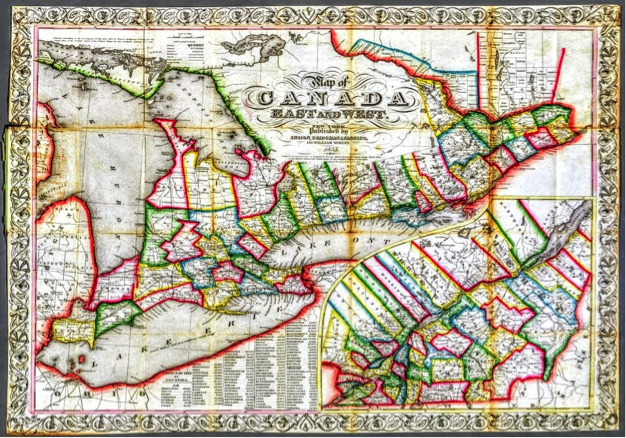“I have saved this book all these many years. Think and read before you destroy it. Thought and prayer my darling,” Love, M… - 1835
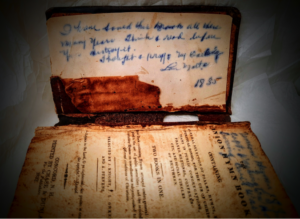 There’s an antique hymnal tucked away in the wilds outside Boise, Idaho. The pages are jaundiced and “crackled,” and they seem to move away from the hinges and endbands as if by design. Inside this venerable old book, there’s an inscription...
There’s an antique hymnal tucked away in the wilds outside Boise, Idaho. The pages are jaundiced and “crackled,” and they seem to move away from the hinges and endbands as if by design. Inside this venerable old book, there’s an inscription...
Varicolored inks recede from the well-penned markings along the ancient pastedown. It’s here against the board where her message is. She writes in a tone of loving admonition; her “voice” inviting her darling to “thought and prayer” before it fades into a signature of murky identity. Now, as I read her inscription so many years later, I have to wonder if she wouldn’t be pleased to know that not only did the book survive, but so did her words – even if the memory of just who she was has been obscured by the receding inks of her own time.
*
The hymnal itself isn’t all that special. After all, it’s just another humble old book. Published in 1832, it’s well worn and said to have been carried by my great-great-great-grandfather Captain Washington Hoyt[1] during the Civil War. By this time, the hymnal had already traveled hundreds of miles from its original home in New England, making its way through “Canada English” and life amongst the Quebecois before coming to rest at a peaceful farm in Iowa. Indeed, the hymnal was a quarter-century-old when “Washington” obtained his honorific of “Captain,” and (perhaps) carried it off to war to the sounds of Somebody’s Darling.[2] No, it isn’t the hymnal itself that’s all that unusual, but rather the identity of the author of its fading inscription and the succession of stewardesses that have made this treasured keepsake so unique.
Recently, my cousin (and the hymnal’s present steward-ess) shared some images of the old book. Together, we’ve marveled at the hymnal’s journey and its “relative” age in relation to our family’s history. You see, my cousin and I live out in the Wild Wild West, and while we’ve noted the hymnal’s youthful age at only “shy of two-hundred years old,” we know too that anything that might have survived our family’s Manifest Destiny urges is, for us, truly something rare. (Only so much would fit on that wagon train…)
Together, we’ve marveled at the hymnal’s journey and its “relative” age in relation to our family’s history.
As my cousin and I marveled at Grandpa Hoyt’s book, and as I started to upload some of its images onto Ancestry, I noted, too, that aside from a time when the old book traveled with our progenitor Washington Hoyt, the book has been held exclusively by a long line of his female descendants. Oddly enough, this succession seems to have come about almost as if pre-ordained or arising from an (apparently) unspoken design.
To better explain this unique stewardship though, I need to digress just-a-sec back to the inscription in Washington’s hymnal. Written in a loving hand to “my darling,” the authoress’s signature reads like it has been signed, “Matte." Nevertheless, due to the blurring of ink and inconsistencies in her signature, we just aren't exactly sure what it does say. My cousin and I also haven't been unable to place anyone by the name of “Matte” in our family tree, or if “Matte” was just a tender nickname for Washington’s wife, Mary (Lawrence) Hoyt.[3] We also haven't been unable to identify “Matte” as a nickname “in general” for the name “Mary.” Washington Hoyt and Mary Lawrence were married in October 1835, the same year as the inscription was written. While it's only speculation, could the old book have been a wedding gift from Washington's new bride Matte?
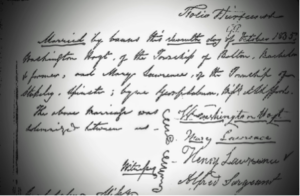 We wondered who else might have written such a loving note of admonition (other than Washington's wife Mary) and wondered if that someone couldn’t have been Sarah (Chapman) Hoyt, his mother.[4] Sarah Hoyt played a significant role in her eldest son Washington’s life, traveling with her husband Amherst (Washington's father) and wife Mary (and a gaggle of other Hoyts) from their “well-rooted” Loyalist enclave in the Eastern Territories to their new home along the Mighty Missouri. Could the direction to “thought and prayer,” be more the words of a mother for her newly-married son than those of a new bride? Is that fading signature actually “Mother…” altered in time to the nickname “Matte?” Indeed, if the hymnal was given to Washington Hoyt in 1835, does it make more sense for his mother to have given him a book that she had saved “all these many years” – or for it to have come from his young bride? It’s tough to know.
We wondered who else might have written such a loving note of admonition (other than Washington's wife Mary) and wondered if that someone couldn’t have been Sarah (Chapman) Hoyt, his mother.[4] Sarah Hoyt played a significant role in her eldest son Washington’s life, traveling with her husband Amherst (Washington's father) and wife Mary (and a gaggle of other Hoyts) from their “well-rooted” Loyalist enclave in the Eastern Territories to their new home along the Mighty Missouri. Could the direction to “thought and prayer,” be more the words of a mother for her newly-married son than those of a new bride? Is that fading signature actually “Mother…” altered in time to the nickname “Matte?” Indeed, if the hymnal was given to Washington Hoyt in 1835, does it make more sense for his mother to have given him a book that she had saved “all these many years” – or for it to have come from his young bride? It’s tough to know.
So while her identity may remain obscured by time and shrouded in ink’s mystery, her message isn’t. Further, whoever she was, mother or wife, she began for Captain Washington Hoyt (and for the rest of her descendants) the eight-generation (thus far) line of successive female stewards for the old hymnal that we have today. Consider this:
Sarah (Chapman) Hoyt – or – Mary (Lawrence) Hoyt, who gave the hymnal to...
Captain WASHINGTON HOYT, the owner of the hymnal, who left it to his wife,
Mary (Lawrence) Hoyt, who left it to her daughter,
Mary (Hoyt) Wilcox, who left it to her eldest surviving daughter,
Elva (Wilcox) Broadhurst, who left it to her niece, her elder sister’s eldest daughter,
with a natural child, a daughter, who was,
Doratha (Lee) Durning, who left it to her daughter,
Doris (Durning) Davis, who left it to her daughter,
Janet … who in the future will leave it to her daughter,
Allisandra ... who may leave it to her niece,
Kendra … who may…
You see, as it happens the hymnal has been handed down to the eldest surviving daughter of each new generation. (And, yes, we here may be a bit ‘thick’ in the head to have taken eight generations to have figured this all out just about now. Each generation has to rediscover important things anew...) For the most part, this “order of successors” seems almost random, that is, it hasn’t been consciously planned (in so far as we can now know). I have to smile when I imagine the inscription's (now unknown) author sitting at her writing desk in 1835 planning this all out. Seriously, did she know? Was this unspoken line of female stewards for Washington’s hymnal her plan all along?
I should mention that there were a couple of “breaks in the line,” too. Truthfully, these breaks were more “course corrections” than anything else, in that they didn’t affect “the line” of the old book’s stewardesses – rather, they complemented it, and even (if you will) completed it. For instance, Mary (Hoyt) Wilcox's eldest daughter Ono (Wilcox) Lee predeceased her, causing Mrs. Wilcox to leave the hymnal to her younger surviving daughter Elva (Wilcox) Broadhurst. However, when the time came, Elva didn’t pass the hymnal on to her own daughter Sally, but rather she returned it to her deceased sister’s (eldest) daughter, Doratha (Lee) Durning, thus returning it to the correct (?) line of succession. Doratha was the only one who left any written instructions for where the old book should go next, and all this (seemingly) unknowingly, and yet in keeping with an already “preordained” line of female successors.
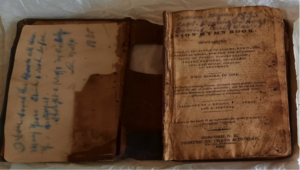 Right now the goal of the present steward-ess (and our family) isn’t so much to discern the hymnal’s mysteries, but rather the preservation of Captain Hoyt’s old book itself. You see, amid all this storytelling of faded signatures, mysterious authors, and antique hymnals, my poor cousin has reached out to me with very real “how-to” questions about preserving antique manuscripts – a subject I know less than anything about. (Yikes!) So I’ve done my best to direct her to all the “proper authorities” – maybe an archivist at Boise State University or the Idaho State Archives – but I admit I am in way over my head when it comes to such things. (I can’t say though as I’d be disappointed though if conservator Todd Pattison from NEHGS didn't just happen to weigh in here with any suggestions for its immediate safekeeping... Well, it could happen; I'm just sayin’...)
Right now the goal of the present steward-ess (and our family) isn’t so much to discern the hymnal’s mysteries, but rather the preservation of Captain Hoyt’s old book itself. You see, amid all this storytelling of faded signatures, mysterious authors, and antique hymnals, my poor cousin has reached out to me with very real “how-to” questions about preserving antique manuscripts – a subject I know less than anything about. (Yikes!) So I’ve done my best to direct her to all the “proper authorities” – maybe an archivist at Boise State University or the Idaho State Archives – but I admit I am in way over my head when it comes to such things. (I can’t say though as I’d be disappointed though if conservator Todd Pattison from NEHGS didn't just happen to weigh in here with any suggestions for its immediate safekeeping... Well, it could happen; I'm just sayin’...)
In the meantime, I hope my cousin (and my ancestors) won’t be too upset if I check a few of my more ersatz sources as we try and figure out what to do. You know, maybe something like that infamous guide Antique Book and Mysterious Signature Preservation in Five Easy Steps, or by looking for clues in the footnotes of Discerning Inscrutable 19th Century Divas for Dummies. You see, the problem here is that there’s a young lady sitting at her writing desk “a la 1835” who counts on us to figure it all out – not to mention a young lady another eight generations from now who will surely be missing out if we don't…
Notes
[1] Captain Washington Hoyt (1809-1886) of the Fourth Battalion, Company A, Iowa Volunteers.
[2] E.K. Crawford, composer, Somebody’s darling (1865) a song from the Civil War associated with the Union cause.
[3] Mary (Lawrence) Hoyt (1810-1890).
[4] Sarah (Chapman) Hoyt (1793-1851).
Share this:
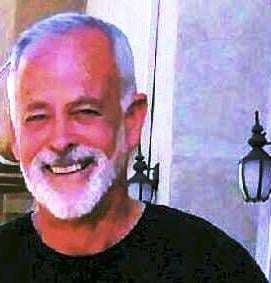
About Jeff Record
Jeff Record received a B.A. degree in Philosophy from Santa Clara University, and works as a teaching assistant with special needs children at a local school. He recently co-authored with Christopher C. Child, “William and Lydia (Swift) Young of Windham, Connecticut: A John Howland and Richard Warren Line,” for the Mayflower Descendant. Jeff enjoys helping his ancestors complete their unfinished business, and successfully petitioned the Secretary of the Army to overturn a 150 year old dishonorable Civil War discharge. A former Elder with the Mother Lode Colony of Mayflower Descendants in the State of California, Jeff and his wife currently live with their Golden Retriever near California’s Gold Country where he continues to explore, discover, and research family history.View all posts by Jeff Record →
